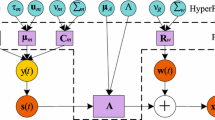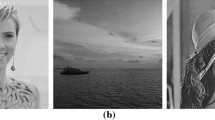Abstract
This letter investigates an improved blind source separation algorithm based on Maximum Entropy (ME) criteria. The original ME algorithm chooses the fixed exponential or sigmoid function as the nonlinear mapping function which can not match the original signal very well. A parameter estimation method is employed in this letter to approach the probability of density function of any signal with parameter-steered generalized exponential function. An improved learning rule and a natural gradient update formula of unmixing matrix are also presented. The algorithm of this letter can separate the mixture of super-Gaussian signals and also the mixture of sub-Gaussian signals. The simulation experiment demonstrates the efficiency of the algorithm.
Similar content being viewed by others
References
Ralph Linsker. Local synaptic learning rules suffice to maximize mutual information in a linear network. Neural Computation, 4(1992)3, 691–702.
S. Becker and G. E. Hinton. A self-organizing neural network that discovers surfaces in random-dot stereo grams. Nature, 355(1992)9, 161–163.
A. J. P. Nadal and N. Parga. Non linear neurons in the low noise limit: a factorial code maximizes information transfer. Network, 5(1994)7, 565–581.
A. J. Bell and T. J. Sejnowski. An information maximization approach to blind separation and blind deconvolution. Neural Computation, 6(1995)7, 1129–1159.
B. Pearlmutter and L. Parra. A context-sensitive generalization of ICA. Proceedings of the international Conference on Neural Information Processing, Hong Kong, 1996, 151–157.
H. H. Yang. Information-theoretic approach to blind separation of sources in non-linear mixture. Signal Processing, 64(1998)3, 291–300.
S. Amari, A. Cichochi, and H. H. Yang. A new learning algorithm for blind signal separation and blind deconvolution. Neural Computation, 7(1995)6, 1129–1159.
Kostas Kokkinakis and Asoke K. Nandi. Multichannel blind deconvolution for source separation in convolutive mixtures of speech. IEEE Trans. on Speech, Audio Processing, 14(2006)1, 200–212.
Author information
Authors and Affiliations
Corresponding author
About this article
Cite this article
Miao, H., Li, X. & Tian, J. An EME blind source separation algorithm based on generalized exponential function. J. Electron.(China) 25, 262–267 (2008). https://doi.org/10.1007/s11767-007-0106-0
Received:
Revised:
Published:
Issue Date:
DOI: https://doi.org/10.1007/s11767-007-0106-0




